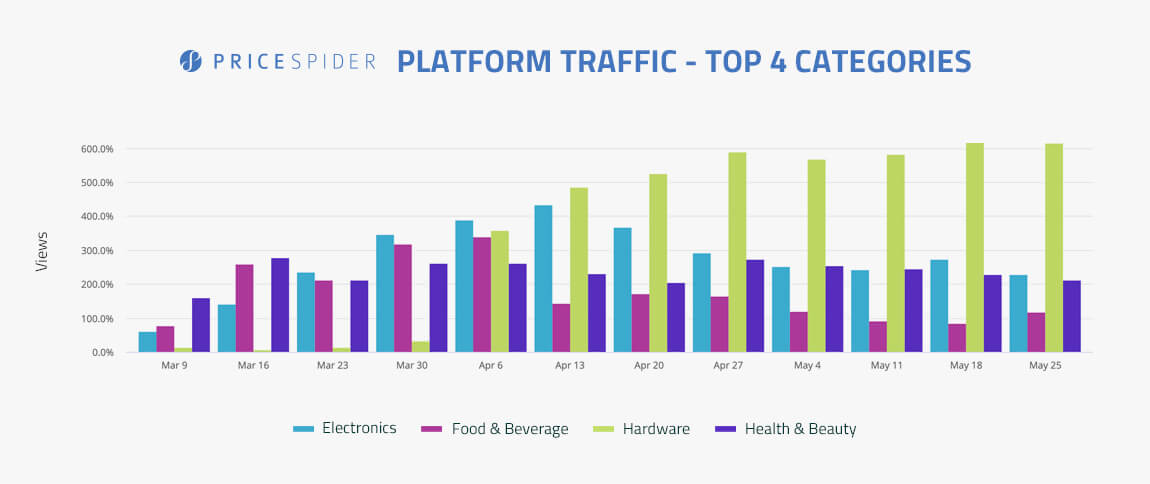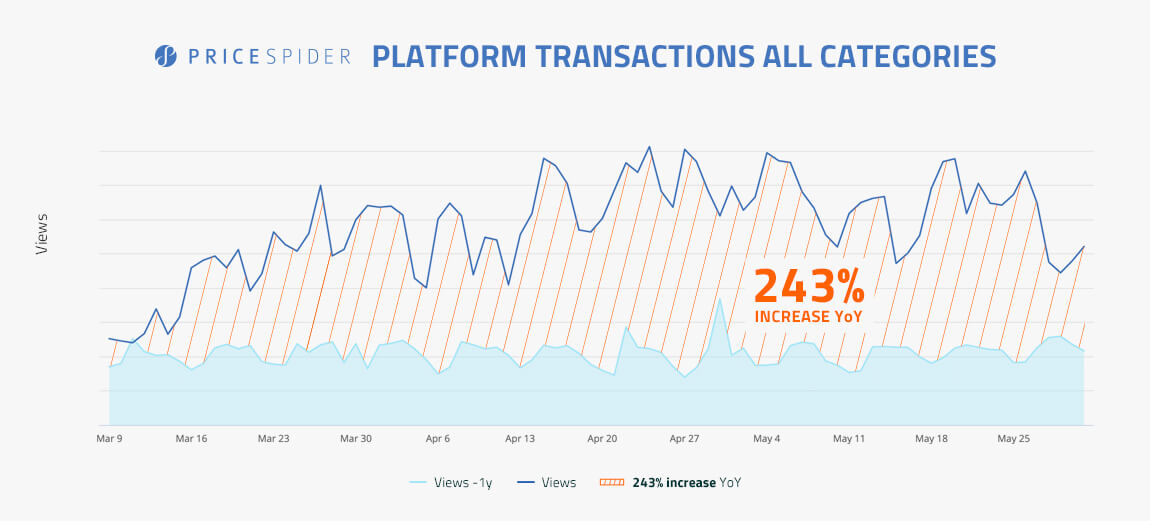Over the last few months, a lot of brands have learned some hard lessons about ecommerce. Almost overnight, American consumers started doing most (or all) of their shopping online. Nearly every product category saw a massive increase in online traffic and transactions. Brands that didn’t have an ecommerce strategy lost ground to their competitors or at the very least, missed some of their opportunity.
We’ve been tracking sales and traffic to brands throughout the pandemic, and many businesses have relied on our conversion optimization platform to maximize product sales. Here are seven things ecommerce brands have learned in the wake of COVID-19.
1. Every brand needs to create a quality online experience
When most of your sales come from brick-and-mortar stores, it’s easy to feel like your website and product pages aren’t that important. But most brands found that when stay-at-home orders rolled out, people started avoiding brick-and-mortar stores, and stock availability tanked, their online traffic went through the roof. Throughout the pandemic, our platform saw a significant increase in direct traffic to brands across nearly every product category.

Ecommerce is always open. Consumers were looking to brands to tell them where products were in stock. They were buying directly from brands. And the brands that didn’t invest in conversion optimization saw a smaller percentage of sales from all that traffic.
2. It’s a lot harder to prepare for a crisis during a crisis
A pandemic isn’t the ideal time to just begin investing in the digital shelf. Every day that you didn’t provide a high quality online shopping experience, you were leaving money on the table. And even if you already had the expertise and tools you needed, employees were dealing with challenges like:
- The transition to working remotely
- School closures and child care
- Loss of family income
- Keeping their families healthy
- The scarcity of essential products
Some people do their best work when they have deadlines and pressure to perform. But that doesn’t work when the deadline is always “yesterday” and the pressure never lifts. If you want to succeed even in the midst of a crisis, you need to be prepared before it happens. For brands, that means making it a priority to win the digital shelf and invest in your website experience.
3. Consumers will buy just about anything online
Historically, food and beverage companies have struggled to gain traction in ecommerce. It was a product category people simply weren’t buying online. COVID-19 changed that. Grocery stores remained open, but many people were wary of shopping in-person and avoided it as much as possible. Whether people were buying online and picking up in-store (BOPIS) or simply ordering online, they were shopping from home as much as possible.

Even alcohol companies, which have had to navigate the challenges of state liquor laws, have been investing in solutions to sell their products online.
4. Shoppers needed help finding products in stock
COVID-19 significantly disrupted supply chains. Even brands that didn’t have to close factories or warehouses found themselves struggling to keep up with demand as panic buying swept the country. Limited stock availability was one of the reasons brands saw such a huge increase in direct traffic–consumers were looking to brands to find out where their products were in stock. Why go from store to store or website to website when you can just check one website to find what you need?
Or at least, that’s how consumers want it to work. Some brands took advantage of where to buy solutions to show local and online stock availability, and even provided ways for consumers to sign up for stock alerts, so they’d find out the moment their favorite products were in stock again. Brands that didn’t have these solutions forced their customers to keep checking with individual retailers or choose an alternative that was in stock.
5. Brands with diverse distribution networks were less affected
While ecommerce has continued to thrive, COVID-19 has had devastating consequences. One of which is that even some large national retailers have had to close their doors for good.
Brands with a diverse distribution network were least impacted by these closures. Their products were still available through other retailers, marketplaces, and sellers, so consumers could still find and buy them. But for brands relying on a single retail partner (or even a few of them), each closure had a massive impact that made it significantly harder for consumers to find their products while they scrambled to find new retail partners and distribution methods.
6. You still have to protect your price in a pandemic
In the absence of brick-and-mortar stores, there’s been an explosion of new sellers filling the gap in online marketplaces. It may be tempting to think that these new sellers are helping you compensate for the loss of sales from physical stores, but many of these sellers are just out to make a quick buck. They don’t care about your brand, and they’re not worried about margins.
Even in a pandemic there are sellers playing pricing games and challenging many brands’ MAP policies. Our price protection software has detected pricing violations throughout the pandemic–at a time when many brands aren’t paying as much attention to enforcing their price. Brands that chose to let violators slide during the pandemic by taking a MAP holiday are going to have to do a lot more work to clean up their brand in the future. Or worse, if brand’s pause monitoring, they lose all visibility on pricing during this valuable data gathering time that will provide them with invaluable data to guide their future.
7. Americans don’t want “we’re all in this together” ads
Marketing throughout the COVID-19 pandemic has been pretty repetitive. New cliches like “we’re all in this together” and “in these uncertain times” quickly worked their way into messaging from all kinds of brands, flooding people’s inboxes and screens.
If you want to talk about a crisis as a brand, you need to be relevant, not repetitive. A lot of brands found that their efforts to be comforting turned their brand into comedic fodder or disenchanted consumers.
See what we’re learning as ecommerce continues to change
While millions of Americans are out of work and many businesses are being forced to close, companies that deliver quality ecommerce experiences are thriving right now. Throughout the COVID-19 crisis, we’ve tracked how the pandemic has affected the world of ecommerce, and shared some of the unique insights that emerged from our data.
Want to keep up with how ecommerce is changing?
Subscribe to our newsletter below. We’ll have something new to share with you every week, so you’ll always be in the know.

